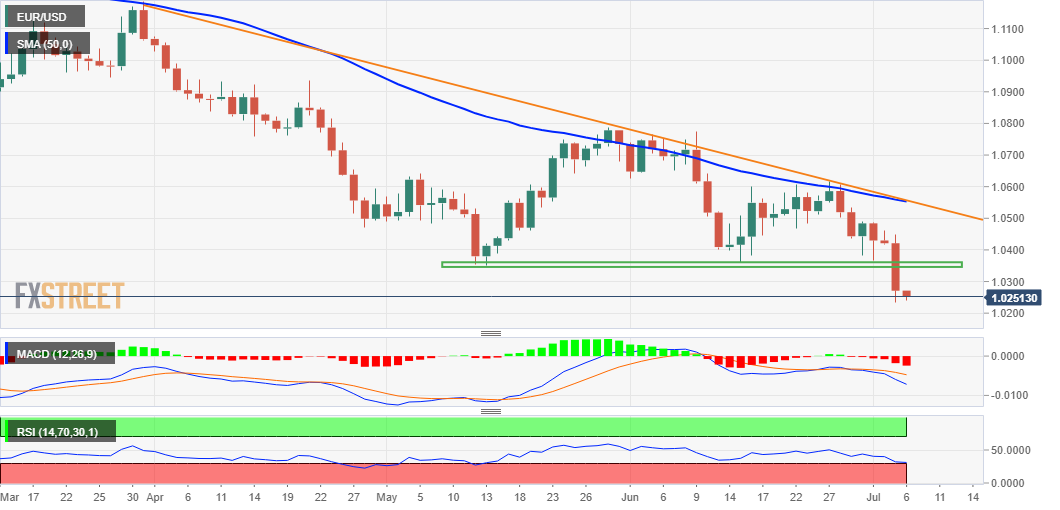- A combination of factors dragged EUR/USD to its lowest level since December 2002 on Tuesday.
- A further rise in gas prices fueled recession fears and weighed heavily on the shared currency.
- Aggressive USD buying also contributed to the selling bias and confirmed a fresh bearish break.
The EUR/USD pair plunged to its weakest level since December 2002 on Tuesday, and the steep intraday decline was sponsored by a combination of factors. The shared currency was pressured by a big jump in natural gas prices, which could drag the Eurozone economy faster and deeper into recession. Moreover, the risk of gas shortages that could disrupt industrial activity across the region if Russia cuts off supplies forced investors to trim ECB tightening bets. This comes on the back of German Bundesbank chief Joachim Nagel's caution on Monday against the use of the anti-fragmentation tool to shield highly indebted countries from surging borrowing rates. Apart from this, a blowout US dollar rally further contributed to the pair's overnight slump.
The Federal Reserve’s non-stop chatter about rate hikes to curb soaring inflation continued lending support to the USD. Apart from this, the prevalent risk-off environment lifted the safe-haven buck to a fresh two-decade high. The market sentiment remains fragile amid concerns that rapidly rising interest rates and tightening financial conditions would challenge global economic growth. Apart from this, the ongoing Russia-Ukraine war and the COVID-19 outbreak in China have been fueling recession fears. This, in turn, tempered investors' appetite for perceived riskier assets, evident from a weaker tone around the equity markets. Meanwhile, the USD bulls seemed unaffected by the recent slump in the US Treasury bond yields.
That said, extremely overstretched conditions forced the USD bulls to take a brief pause and helped limit any further losses for the EUR/USD pair, at least for the time being. Traders also seemed reluctant to place aggressive bets. They preferred to wait on the sidelines ahead of the FOMC monetary policy meeting minutes, scheduled to be released later during the US session this Wednesday. The minutes would be scrutinized for fresh clues about the Fed's policy tightening path. Apart from this, the US monthly jobs report (NFP), due on Friday, will influence the near-term USD price dynamics and provide a fresh directional impetus to the major. Nevertheless, the fundamental backdrop supports prospects for an extension of the well-established bearish trend.
Technical outlook
From a technical perspective, the convincing overnight breakdown through the 1.0350 horizontal support adds credence to the negative outlook. That said, RSI (14) on the daily chart has moved on the verge of breaking into the oversold territory and makes it prudent to wait for some near-term consolidation or modest rebound before the next leg down. Hence, any subsequent decline will likely find some support near the July 2002 swing high, around the 1.0200 round-figure mark. Some follow-through selling, however, would be seen as a fresh trigger for bearish traders and pave the way for additional losses. The EUR/USD pair would then turn vulnerable to challenge the parity mark.
Conversely, any meaningful recovery attempted might confront stiff resistance and attract fresh selling near the 1.0300 round-figure mark. This, in turn, should cap the EUR/USD pair near the 1.0350 support breakpoint, now turned resistance, which seems to act as a pivotal point. Sustained strength beyond could trigger a short-covering move and allow bulls to reclaim the 1.0400 mark, though the momentum runs the risk of fizzling out rather quickly.






